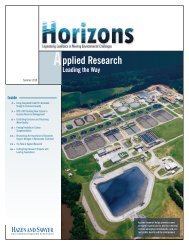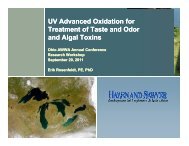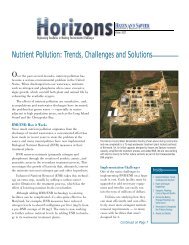Download - Hazen and Sawyer
Download - Hazen and Sawyer
Download - Hazen and Sawyer
You also want an ePaper? Increase the reach of your titles
YUMPU automatically turns print PDFs into web optimized ePapers that Google loves.
the plant experiences poorer settling,<br />
<strong>and</strong> there is a process risk in using<br />
such properties. Risk can be substantially<br />
minimized by evaluating clarifier<br />
capacity under more critical settling<br />
conditions. In this particular case, the<br />
95th percentile of the SVI was selected<br />
to represent poor settling. Since the<br />
Vo <strong>and</strong> K for the 95th percentile SVI<br />
differ from the values measured during<br />
the field visit, it is necessary to correlate<br />
the two different measurements.<br />
Several researches have published a<br />
different relationship between these<br />
parameters, <strong>and</strong> it is the designer’s<br />
task to find the correlation that best<br />
fits the data set.<br />
Modeling results indicated that<br />
Facility A’s clarifier performance<br />
strongly depends on the settling properties<br />
<strong>and</strong> is severely compromised when the<br />
settling properties are poor. The model suggests<br />
that peak flow can be sustained only for 9 hours,<br />
after which time a significant loss of solids occurs<br />
through the effluent weirs. The model indicates<br />
this failure occurs due to thickening limitations.<br />
Total RAS flows of 0.66 m 3 /s (15 mgd, 50%) <strong>and</strong><br />
0.88 m 3 /s (20 mgd, 66%) were evaluated <strong>and</strong><br />
proved ineffective in controlling the rise of the<br />
blanket. Additional clarifier area or the implementation<br />
of a wet weather strategy is needed to<br />
prevent clarifier failure under these conditions.<br />
Validating Wet Weather Strategies<br />
Wet weather events usually pose additional<br />
challenges to the unit treatment processes.<br />
Successful post-storm treatment depends on a<br />
plant’s ability to retain the solids inventory <strong>and</strong><br />
maintain an active biomass. These factors, in<br />
turn, depend on secondary clarifier performance.<br />
If poor settling conditions occur simultaneously<br />
with peak flows, the performance of any secondary<br />
clarifier can be severely compromised.<br />
The 2Dc model was used to evaluate wet<br />
weather strategies in two scenarios. In Facility<br />
B, a calibrated CFD model was used to evaluate<br />
the effect that step feed <strong>and</strong> nonstep feed modes<br />
can have on clarifier performance. A calibrated<br />
model was used to predict the MLSS concentration<br />
under both scenarios for the case of a storm<br />
event in which the clarifier SOR rises from 0.54<br />
to 1.38 m/h in about 24 hours <strong>and</strong> the peak flow<br />
is sustained for other 24 hours. The analysis<br />
was conducted for two existing 39.6-m-diameter<br />
(130-ft-diameter), 3.7-m (12-ft) side-water-depth<br />
secondary clarifiers.<br />
Figure 4. Retrofitted Final Settling Tanks Suspended Solids Contours (Facility D)<br />
FST = final settling tank.<br />
MLSS = mixed liquor suspended solids.<br />
SOR = surface overflow rate.<br />
Modeling results demonstrated that the use<br />
of step feed considerably decreases the solids<br />
loading in the secondary clarifier, resulting in a<br />
lower ESS during the storm event. Without step<br />
2Dc Model Capabilities<br />
RAS = return activated sludge.<br />
ESS = effluent suspended solids.<br />
WLR = weir loading rate.<br />
Simulation Capabilities of General Model<br />
• Inlet, settling, <strong>and</strong> outlet zones<br />
• Steady <strong>and</strong> unsteady conditions for mass <strong>and</strong> hydraulic<br />
loadings<br />
• Dynamic inventory of the sludge blanket<br />
• Flocculation inside the tanks<br />
• Temperature variations <strong>and</strong> heat exchange<br />
• Density currents<br />
Additional Capabilities for Circular Clarifiers<br />
• Modeling of center-feed <strong>and</strong> peripheral-feed clarifiers<br />
• Modeling of inlet deflectors<br />
• Simulation of center-well, canopy, midtank (Crosby) baffle<br />
<strong>and</strong> peripheral (Stamford) baffle, positive or negative slope,<br />
inboard or outboard launder, <strong>and</strong> simple inlet arrangements<br />
• Simulation of solids removal systems (hopper or suction),<br />
constant or proportional recirculation flow rate, <strong>and</strong> rake or<br />
spiral scraper simulation<br />
Additional Capabilities for Rectangular Clarifiers<br />
• Modeling of solids or porous inlet walls<br />
• Modeling of different types of skits, positive or negative slope,<br />
inboard or outboard launder, <strong>and</strong> simple inlet arrangements<br />
• Modeling of perforated baffles<br />
• Simulation of solids removal systems, constant or proportional<br />
recirculation flow rate, <strong>and</strong> scraper simulation<br />
• Simulation of floatable <strong>and</strong> nonsettling particles<br />
© 2008 Water Environment & Technology All rights reserved<br />
o c t o b e r 2 0 0 8<br />
57








